The Physicist Organization Network reported on August 21 (Beijing time) that Princeton University engineers developed a wallpaper embedded in an ultra-thin radio system that could turn the entire wall into a giant radio. The researchers said that this technology laid the foundation for the development of a variety of devices such as built-in wireless communication systems and road and bridge structure monitoring devices.
"Initially, we wanted to make it an internal energy management system for smart buildings," said Navin Wilma, an assistant professor of electrical engineering at Princeton University, who is one of the project's principal researchers. "The distributed radio array inside the 'wallpaper' will Sensors and sensors are connected to the central management system.†This kind of radio “wallpaper†can also be painted with various patterns like real wallpaper. It is soft and flexible and can be used on a variety of irregular surfaces, such as bridge faces or pillars. . There are solar cells on the plastic film and they can supply power on their own.
The biggest problem with arranging circuits on plastics is that the plastic melts or deforms at high temperatures. In order not to damage the plastic, the researchers used a lower frequency amorphous silicon thin film transistor. But radio equipment required higher frequencies to work properly. For this reason, they used their own way to use a design called “super-regenerative circuit†developed by Edwin Armstrong, “father of radioâ€, in 1922, through capacitors and sensors. To increase the radio frequency.
Making large sensors is usually easier than small ones, which is an advantage of this research. "Nobody regards 'big' as a place to improve performance, and that's our breakthrough," Verma said.
Next, the research team plans to develop a flexible structure safety monitoring system for bridges, buildings, pipelines and other structures. Currently, engineers use single-point sensors or fiber optics to detect structural problems. Devices collect data from a small area. The university’s associate professor of urban and environmental engineering, Blank Griesk, said that in a large structure, the problem may come from any point. If there is no sensor at this point, it is difficult to find the problem. Plastic sensing films, unlike point systems, can accommodate many interconnected sensors and detect problems that will occur over a large area. The researchers stated that they are testing on a scale model and the prototype will be available in September. It may take another few years to enter the actual application. (Reporter Chang Lijun)
Ningxia Huahui Activated Carbon Company Limited (Huahui Company) was founded in 1992, its registered capital is 1.6912 billion yuan, production capacity is 35000 tons every year. With more than 20 years` experience in foreign trade, HuaHui Company is one of the key enterprises of foreign trade in Ningxia Hui Autonomous Region.
Huahui activated carbon can be divided into pellet carbon, granular carbon, impregnated carbon , acid washed carbon, powder carbon and briquette carbon etc, more than 6 kinds and hundreds of specifications. This kind of carbon can meet the diverse needs of customers.
All types impregnated carbon, such as impregnated KOH.NaOH.CUO.FE2O3.SILVER.SULPHUR ,KI,KBR,H3PO4,H2SO4,KMNO4, Chrome 3%+CU 7%and so on or as clients requirements.

H3PO4 Pellet Activated Carbon,Pellet Carbon With H3PO4,H3PO4 Impregnated Pellet Activated Carbon
Ningxia Huahui Activated Carbon Company Limited , http://www.huahurcarbon-tr.com